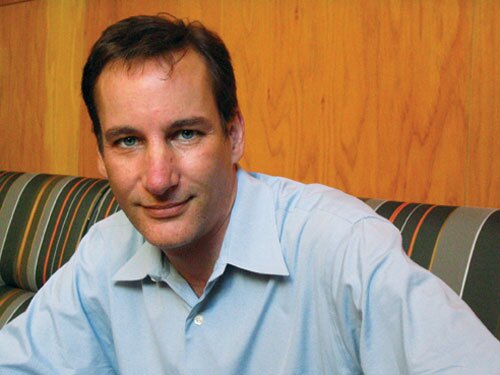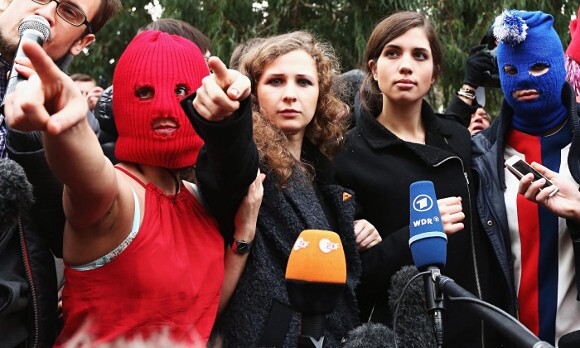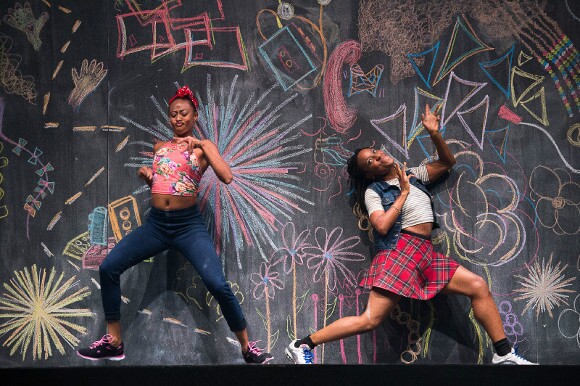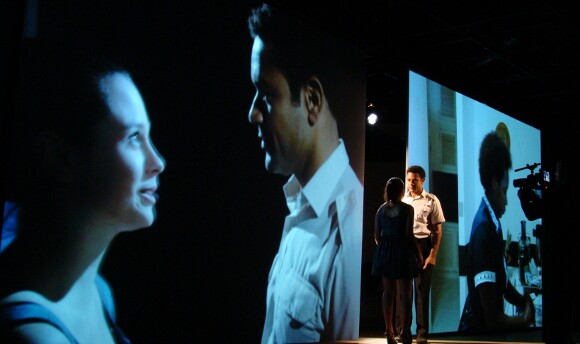Programming Los Angeles: A Chat With the Executive Directors of REDCAT, Bootleg Theater, and CAP UCLA
When it comes to programming options, Los Angeles has an embarrassment of riches, says Kristy Edmunds, artistic and executive director of the Center for the Art of Performance at UCLA since 2011. "Los Angeles is an enormous cosmopolitan city with an extraordinary range of artists, practitioners and programming, and as an inhabitant you're spoiled for choice," she says.
Indeed, the town has come a long way from Woody Allen's L.A.-phobic, "Annie Hall" days, when his alter ego, Alvy Singer, declared in the 1977 film, "I don't want to live in a city where the only cultural advantage is that you can make a right turn on a red light."
Aesthetically -- and metaphorically -- speaking, those red lights have seemingly turned very green, with more happening in the performing, visual and literary arts in this burg than ever before. And it's not just Edmunds who is helping drive the shifting cultural landscape, but, further east, Mark Murphy, executive director of REDCAT (Roy and Edna Disney/Cal Arts Theater), has also put his artistic stamp on our sprawl-to-the-wall cosmopolis with his hip programming since the black box's 2003 opening.

Add to those names that of Jessica Hanna, producing and managing director of the Bootleg Theater, whose owners Alicia and Jason Adams secured the space west of downtown in 1999, when it was the Evidence Room, before the three of them co-founded the Bootleg in 2006, and a bevy of cultural bases are covered in the City of Angels.
In the last few weeks alone, L.A. has seen Yuval Sharon's astonishing a "Hopscotch" the opera for 24 cars -- Edmunds' colleagues at UCLA's Hammer Museum worked with Sharon to conceive "Terry Riley: In C, A Performance Installation by The Industry," an installation/performance in the Museum's courtyard featuring Riley's iconic score performed with musicians, Ate9 Dance Company and inflatable air dancers by artist Doron Gazit -- a week-long retrospective of Anne Teresa De Keersmaeker's work with her Rosas dance troupe at UCLA, as well as Young Jean Lee's West Coast premiere, "Straight White Men," a co-production between CAP UCLA and Center Theatre Group.
REDCAT's recent schedule also featured a plethora of unique shows, among them performance artists John Fleck and Kristina Wong, as well as cabaret diva, Joey Arias, while the Bootleg, in collaboration with Rogue Artist's Ensemble, just opened the world premiere, "Wood Boy Dog Fish," a modern, macabre retelling of bad boy puppet Pinocchio.

For Murphy, who was born in Boise, Idaho in 1961 and comes from an artistic family -- his father was an actor and singer who was also the "voice" of the New York World's fair; his mother a painter and costume designer -- the responsibility of "being lit" 300 nights a year at REDCAT is the norm, his programming also branding him as an arbiter of taste.
"The first questions I ask myself, in terms of the presenting and visiting artists," Murphy explained, "are what works really need to be seen by artists, audiences and critics in L.A., in order to be current or well-informed about significant developments in the field.
"I would not want to use the term required reading," added Murphy, who served as artistic director of Seattle's performing arts center, On the Boards, from 1984 to 2001, "but in a way, that's partly what it is -- who is doing something fresh and important that people need to be aware of -- in order to be up to speed in the art forms."

Murphy also wants artists to have something unique and important to say. "That doesn't have to be in a narrative form, but could be in a non-spoken way -- about the art or about our changing society and the human condition," he continued. "Part of that is making sure that the program over all reflects voices from different parts of the world and different cultural influences."
Soft-spoken, the perpetually upbeat Murphy said that this is especially important in L.A.
"For a long time people thought of us as the back door entrance for the United States, with New York the front door, whereas I think the cultural influences from Latin America and the Pacific rim are so important that I consider us to be the front door -- after a little remodeling. Hopefully," he added with a laugh, "it's not just a shotgun apartment, but there's some resonance."

REDCAT's annual New Original Works (NOW) Festival and ongoing Studio series, the latter featuring informal new performance works and works-in-progress, have also benefited local artists. Murphy said his criteria for mounting such works are similar to those he applies to imported work. He also factors in an aesthetic trajectory.
"Are they doing another version of what they've always done or are they going to take the opportunity to create a new way of telling a story or a new form -- to do something that goes deeper."
Most of us do go to the theater to experience a form of heightened reality, as well as to be impacted emotionally.
Hanna, 44, was born in Ithaca, New York, and came to L.A. in 1996, where she has worked as an actor, director, choreographer and producer. The Bootleg, an inclusive art space for original, boundary-defying live theater, music, and dance performances, was born from the diverse cultural and artistic landscape of L.A.
The Bootleg is primarily known for its co-productions with other companies. "We're looking to support companies that don't have spaces and for work that is bold and daring," explained Hanna. "Our audience tends to be adventurous and we're looking for pieces that would challenge our audience that way. Of course, we want to be moved by something, as well."
Finding the work is a crucial part of the job, and Hanna said she is particularly interested in what's happening locally. "Work tends to come to us, and when an artist walks in the space, ideas start popping."
Bootleg's dance element has been a boon for local choreographers and troupes. In September, Licia Perea, who was recently appointed Bootleg's director of dance, presented the third annual BlakTina Festival, celebrating Black and Latina choreographers. Bootleg, in collaboration with the L.A. branch of Pentacle, a service and support organization, has also presented the dance festival, Homegrown. And, last June, the Lester Horton Awards, a celebration of Southern California's dance community presented by the Dance Resource Center, took place at the equity waiver-sized space.

No stranger to awards herself, Edmunds, 50, who was born in a small town in Washington state, was the first visiting scholar at Philadelphia's Pew Center for Arts & Heritage this year. Her astonishingly prolific career also includes founding the Portland Institute of Contemporary Arts (PICA), and its TBA (Time Based Art) Festival in Oregon in 1995, as well as heading Australia's Melbourne Festival and New York's Park Avenue Armory.
Articulate and near zealous when it comes to the arts, Edmunds put into play her years-long relationships with some of the world's greatest artists, including theater/opera director Robert Wilson, composer Philip Glass and performance artist Laurie Anderson, by instituting long-term residences, as well as shorter term fellowships at UCLA.
Her abiding love for dance has also been evident in programming: In 2013, Edmunds gave the groundbreaking choreographer, Trisha Brown, now 79, a retrospective, including presenting, "Man Walking Down the Side of a Building."
The director recently explained that programming decisions don't necessarily occur in single projects or in single artists. "One of the things I look at from the institution itself, a criteria for us -- meaning the Center -- is: Do we have adequate resources to support the work as it was intended to be experienced by a public -- which is not as easy as it sounds -- the ability to find avenues of context and connection to diverse publics from the students to academic scholar areas, to the general public; and are we able to build bridges and connections across different kinds of people? I try and look at those projects which are very robust and how they land here and how I can hold that work well here."
Edmunds pointed out that everything seen on stage has an impact on culture. "When I am looking at work and different artists and companies and bands and theater makers, there's not a fixed criterion line. I look at the maturity of that vision, the timeliness of that idea, the depth and rigor of the creative development -- their commitment to the idea long term, and their own contribution to the art form that they're working in predominantly."
Of course, Edmunds, who seems to have audaciousness in her DNA, also relies on "a kind of gut instinct. You can feel an elevated sense of trust, even if a work doesn't exist, you know in the hand of that artist, it's going to have exceptional value and matures and lands on the stage."
This kind of thinking parallels Edmunds' desire to dive deeper into an artist's ouevre. When she brought De Keersmaeker and Rosas, that week included performances of four different works -- ranging from the years 1982 to 2014 -- a master class and a conversation with the choreographer.
Edmunds said, however, that it wasn't a residency, a festival or a retrospective. "It [was] an in-depth survey in key arcs in this hugely significant choreographer's practice. To me it's like opening multiple nights and multiple projects to an audience being in-residence."
Edmunds understands her responsibilities -- to audiences, board members and the institution itself. "Some kinds of projects and works, by the nature of their distribution, are very transactional -- they're not going to hang around for a week, with special talks on campus, and salons with the public. And I'm often working with my peer counterparts, in multiple cities over multiple art forms. If there is one gap in a three-day [engagement] with a dance company or theater ensemble that three days can make or break an entire tour.
"The question is how to close the gap. There's a lot of commitment and multiple years of discussion that go into these things -- then visas, protocol, homeland security -- and the resources to get the visas in position."

Knowing that UCLA has had a performing arts live presenting program for close to 80 years, Edmunds said, "When you look at that, you have to look across multiple decades and chapters and eras that have committed to exploring the practices of live performance.
"There's probably chapters in which historically speaking, it was one of the only things standing. Royce Hall," added Edmunds, "has been here a long time. Different generations have a different set of relations to the hall and to UCLA's commitment to presenting live work. In the current iteration, it's a very vital place for people who care about contemporary practice, in dance, theater, global music, jazz, contemporary [and] classical."
"It's an important arbiter for international and national work, presented with a curatorial integrity around the artist vision."
Edmunds, who noted that her annual operating budget hovers around $3 million, is an aesthetic warrior perpetually on the frontlines, one who brings spirit, vigor and joy to her job. Dance-wise, the 2015-16 season continues in January with eight performances of "Agua Furiosa," a work choreographed by L.A.-based Ana Maria Alvarez for her troupe, CONTRA-TIEMPO.
March brings "Torobaka," a collaboration between the acclaimed U.K.-based choreographer/dancer Akram Khan and Spanish flamenco dancer Israel Galván (hailed as the "Nijinsky of Flamenco"), the fusion of kathak and contemporary flamenco sure to heat up the hall.
Lively conversations are also part of Edmunds' programming, with Ursula K. Le Guin having recently taken the stage and Pussy Riot scheduled for February 11.
Running any performance venue is always a challenge, and Murphy, who said his total organizational budget -- including gallery and operational costs -- is a bit north of $2 million, while his performing arts programming budget is closer to $325K, added that audience awareness and demographics are key. "It's important that we have a young, diverse audience that reflects the demographics of L.A.
"I would rather have an audience respond passionately -- either positively or negatively -- than to just say [a performance] was OK," Murphy said. "We're an intimate space and we are an extension of a risk-taking institution, CalArts, which was created to encourage the development of new forms through experimentation."

Murphy has stuck to that credo, bringing in troupes like Elevator Repair Service, the New York-based company that mounted "Gatz," an eight-hour reading/performance of "The Great Gatsby" in 2012, or serving as a West Coast base for the Wooster Group, whose engagement last January of "Early Shaker Spirituals: A Record Album Interpretation," featured among others, Oscar winner, Frances McDormand.
"I first worked with Wooster in 1987 in Seattle," Murphy recalled. "After REDCAT opened, we found some funding to help subsidize three years of almost annual visits by the company, because it seemed like so many artists in L.A. cite them as an important influence, yet many hadn't seen the work -- they'd only read about it."
"It seemed important to have them," continued Murphy, "and over that three years, an audience was built for them. Now the relationship is able to continue."
In February, the Wooster Group performs the world premiere of Harold Pinter's "The Room" (Feb. 4-14), which was Pinter's first play, written in 1957 when the playwright was 27.

Also coming up: The West Coast premiere of choreographer Camille A. Brown's "Black Girl: Linguistic Play" (Dec. 3-6); a world premiere by L.A.-based choreographer Meg Wolfe (Jan. 28-30); and the first L.A. appearances by two companies from Latin America. Brazilian director Christiane Jatahy brings "Julia," a multi-media piece inspired by Strindberg's "Miss Julie" (February 18-21), followed by Chile's TeatroCinema, whose production of "Historia de Amor" (March 31-April 3), is a portrait of an English teacher who abducts a young woman and turns her into his victim, concubine and mother.
Murphy said that these performances reflect the balance between long-term relationships between artists and ensembles, but will also introduce new voices important to the growth of the field.
Another goal of these three presenters is to originate work in L.A. that will then travel. Hanna, operating on a small budget of around $160,000, said she's thrilled that Roger Guenveur Smith's solo show, "Rodney King" began at the Bootleg in the summer of 2012, although, "technically, it premiered at the Kirk Douglas Theatre as part of RADAR L.A. [the international festival of contemporary theater, produced by REDCAT in collaboration with Center Theatre Group and New York Public Theater's Under the Radar Festival]."

Explained Hanna: "I called Roger and said we had some time and does he want to do one of his pieces. He wanted to do something new and I said, 'I don't have much money.' He was thinking about Rodney King and told me what he thought it might be. Now," added Hanna, "Roger's been doing [the piece] in all kinds of places, and it continues to resonate two years later.
"It's cool and timely and seems to always be in a place where questions are asked about race and culture. They did a run at the Brick Theater in Brooklyn and on opening night was the Eric Garner non-indictment."
"Getting our work outside the borders of L.A.," added Hanna, "is a good way to let the country and the rest of the world know about the great art that's happening here. There's a myth that there's no theater here. Yes, there's amazing theater in L.A. and there's a lot of passion for it."

For Murphy, his passion will continue, even as Steven D. Lavine, president of CalArts since 1988, steps down in mid-2017. "I think that Steven has allowed us to create a unique and influential niche -- a brand, if you will -- that has become well-established and recognized that people tell me is important to not just L.A., as part of the arts ecology, but as part of the national and international community."
"I wanted to make sure from the beginning that people saw REDCAT not as part of the shiny Frank Gehry complex where they would see fancy avant-garde things, but as a way to be comfortable. I wanted REDCAT to be a home for the artistic community."
And so it is. Los Angeles, a city that has, for so long, been seen as not having a beating-heart center -- geographically, artistically and otherwise -- is home to a thriving, ever-expanding arts community, thanks, in large part, to people like Edmunds, Murphy and Hanna.
Dig this story? Sign up for our newsletter to get unique arts & culture stories and videos from across Southern California in your inbox. Also, follow Artbound on Facebook, Twitter, and Youtube.


